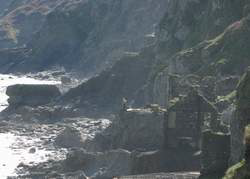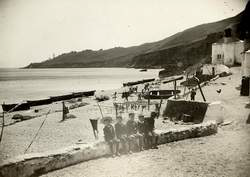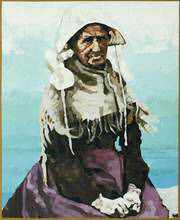Abandoned Communities ..... Hallsands
In the early 1890s Hallsands was a small fishing village on the south coast of Devon. It was protected from the sea by a beach of sand and shingle. Then in 1897 a major dredging operation began not far from the village. Within a few years the level of the beach fell by about twelve feet, and the village was exposed to the direct impact of high tides and easterly winds. Several buildings were damaged or destroyed in storms during 1903 and 1904. Some buildings were repaired, and temporary protection was given by a new sea wall, but another major storm in January 1917 caused further devastation, and the village was abandoned.
Over the last few years several accounts of the history of Hallsands have been published. They include a booklet by Chips Barber, The Story of Hallsands, published by Obelisk Publications in 2001, and a chapter in Leigh Driver’s book, The Lost Villages of England, published by New Holland in 2006. In particular, much relevant research has been carried out by Steve Melia, and published by him in Hallsands, A Village Betrayed, Forest Publishing.
Hallsands lay in Start Bay, just over a mile north of Start Point. It faced east and was sheltered from the prevailing south westerly winds by a steep cliff. For this reason its location may have been favoured by fishermen. The first known reference to a settlement at Hallsands comes in the Stokenham Manor court rolls of 1611.
The cliff immediately behind Hallsands had several flat rocky spurs about ten feet above the high tide mark. It is likely that the first buildings were constructed on these platforms, some of them being built right against the cliff face. Later houses were built partly or wholly on the compacted sand that lay between the rocky platforms. A road ran in front of them. At a later stage houses were added on the seaward side of the road, with walls below them to provide protection from the higher tides.
According to the census of 1891 there were 159 people living in Hallsands at that time, occupying 37 houses. There was a small shop with post office, the London Inn with stables and a piggery, and the Mission Room. By the 1890s the Mission Room was used as a community centre. It had originally been opened for religious purposes, but it was replaced in this respect by a chapel of the Bible Christian denomination built near the top of the cliff in 1858.
The nearest school was at Huccombe, about two miles from Hallsands. The school had been opened in 1878, and children were expected to attend between the ages of 5 and 14. They would have had to walk to and from the school.
Most of the houses in Hallsands were occupied by their owners. They had been offered for sale in 1857 on the death of the previous owner. As Steve Melia has pointed out, the fact that the houses were owner occupied would have had several implications when the village started to be destroyed. People would have been very reluctant to abandon their homes, but the absence of a single powerful landowner may have meant that opposition to the dredging and claims for compensation were relatively weak.
Nearly all the men of the village made their living from fishing, and women and children too would take part in activities related to fishing. Someone would be posted on the cliff top to look out for shoals of fish. Boats would then take seine nets out to sea to surround the fish, and both ends of the nets would be dragged ashore with the fish trapped inside them. More valuable fish were sold, others would be used by the villagers. Many, however, would be used as bait for the other main form of fishing, the catching of crabs. Crabs were caught in pots made locally out of withers, and then stored alive until collected by a boat that would take them to markets such as Billingsgate in London.
Fishing boats were stored on the beach above the high tide mark. In poor weather the task of pulling them ashore was difficult. Newfoundland dogs were trained to swim out to a boat, take a rope, and help to pull it in. According to the reminiscences of Evelyn Lamble, who was a child in Hallsands before its abandonment, on one occasion a dog saved a child from drowning. It brought the child out of the sea and then went to the nearest cottage to seek help.
The reminiscences of Evelyn Lamble and other former inhabitants of the village also stress the social support that villagers would give to each other. On the whole the people were “humble and poor”, but especially during times of hardship they would be happy to help each other.
Recorded reminiscences can be seen at the excellent Local Heritage Resource Centre at the Cookworthy Museum in Kingsbridge.
Over the last few years several accounts of the history of Hallsands have been published. They include a booklet by Chips Barber, The Story of Hallsands, published by Obelisk Publications in 2001, and a chapter in Leigh Driver’s book, The Lost Villages of England, published by New Holland in 2006. In particular, much relevant research has been carried out by Steve Melia, and published by him in Hallsands, A Village Betrayed, Forest Publishing.
Hallsands lay in Start Bay, just over a mile north of Start Point. It faced east and was sheltered from the prevailing south westerly winds by a steep cliff. For this reason its location may have been favoured by fishermen. The first known reference to a settlement at Hallsands comes in the Stokenham Manor court rolls of 1611.
The cliff immediately behind Hallsands had several flat rocky spurs about ten feet above the high tide mark. It is likely that the first buildings were constructed on these platforms, some of them being built right against the cliff face. Later houses were built partly or wholly on the compacted sand that lay between the rocky platforms. A road ran in front of them. At a later stage houses were added on the seaward side of the road, with walls below them to provide protection from the higher tides.
According to the census of 1891 there were 159 people living in Hallsands at that time, occupying 37 houses. There was a small shop with post office, the London Inn with stables and a piggery, and the Mission Room. By the 1890s the Mission Room was used as a community centre. It had originally been opened for religious purposes, but it was replaced in this respect by a chapel of the Bible Christian denomination built near the top of the cliff in 1858.
The nearest school was at Huccombe, about two miles from Hallsands. The school had been opened in 1878, and children were expected to attend between the ages of 5 and 14. They would have had to walk to and from the school.
Most of the houses in Hallsands were occupied by their owners. They had been offered for sale in 1857 on the death of the previous owner. As Steve Melia has pointed out, the fact that the houses were owner occupied would have had several implications when the village started to be destroyed. People would have been very reluctant to abandon their homes, but the absence of a single powerful landowner may have meant that opposition to the dredging and claims for compensation were relatively weak.
Nearly all the men of the village made their living from fishing, and women and children too would take part in activities related to fishing. Someone would be posted on the cliff top to look out for shoals of fish. Boats would then take seine nets out to sea to surround the fish, and both ends of the nets would be dragged ashore with the fish trapped inside them. More valuable fish were sold, others would be used by the villagers. Many, however, would be used as bait for the other main form of fishing, the catching of crabs. Crabs were caught in pots made locally out of withers, and then stored alive until collected by a boat that would take them to markets such as Billingsgate in London.
Fishing boats were stored on the beach above the high tide mark. In poor weather the task of pulling them ashore was difficult. Newfoundland dogs were trained to swim out to a boat, take a rope, and help to pull it in. According to the reminiscences of Evelyn Lamble, who was a child in Hallsands before its abandonment, on one occasion a dog saved a child from drowning. It brought the child out of the sea and then went to the nearest cottage to seek help.
The reminiscences of Evelyn Lamble and other former inhabitants of the village also stress the social support that villagers would give to each other. On the whole the people were “humble and poor”, but especially during times of hardship they would be happy to help each other.
Recorded reminiscences can be seen at the excellent Local Heritage Resource Centre at the Cookworthy Museum in Kingsbridge.
One
The village before major damage occurred. The top picture is a view from the south, the other from the north.
These, and several other photographs in this section, come from the Cookworthy Museum.
For two more views of Hallsands before the dredging go to the Paintings section.
These, and several other photographs in this section, come from the Cookworthy Museum.
For two more views of Hallsands before the dredging go to the Paintings section.
The ruins of Hallsands today
The frame in the foreground was used to hold fish, including skate used as bait in catching crabs
A woman of Hallsands
These two pictures, based on old photographs, have been painted by Patrick Caseley, a native of Kingsbridge




